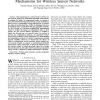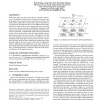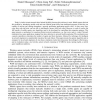897 search results - page 120 / 180 » Efficient RBS in Sensor Networks |
JSAC
2006
14 years 11 months ago
2006
Abstract-- Node compromise is a serious threat to wireless sensor networks deployed in unattended and hostile environments. To mitigate the impact of compromised nodes, we propose ...
MOBIHOC
2009
ACM
16 years 8 days ago
2009
ACM
Most future large-scale sensor networks are expected to follow a two-tier architecture which consists of resource-rich master nodes at the upper tier and resource-poor sensor node...
DSN
2007
IEEE
15 years 6 months ago
2007
IEEE
Sleep-wake protocols are critical in sensor networks to ensure long-lived operation. However, an open problem is how to develop efficient mechanisms that can be incorporated with ...
ATAL
2006
Springer
15 years 3 months ago
2006
Springer
Today's wireless sensor networks have limited flexibility because their software is static. Mobile agents alleviate this problem by introducing mobile code and state. Mobile ...
COMSWARE
2007
IEEE
15 years 6 months ago
2007
IEEE
—Clustering techniques create hierarchal network structures, called clusters, on an otherwise flat network. Neighboring devices elect one appropriate device as clusterhead. Due t...



